Popular Bosozoku cars: Tomica Nissan Skyline KDR30
Last week the poll decided the Tomica Skyline KDR30 as a winner in the sudden death between this car and the Impul Silvia Turbo S12. Therefore I feature a Popular Bosozoku Cars special this week: the Tomica Skyline RS Turbo KDR30! 🙂
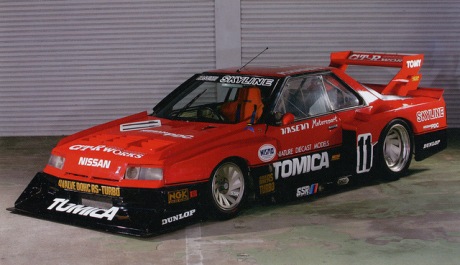
The Tomica Nissan Skyline RS Turbo KDR30 Super Silhouette
The Super Silhouette Formula was fully according to the rules of the FIA Group 5. In 1979 the rules were changed to Generation 4 in which the FIA allowed the so called “Special Production Cars” in which the FIA allowed cars falling in Group 1 to 4 can be modified extensively but restricted the width, the height (roofline) and the shape of the car to remain original (hence the silhouette name). The loophole was that is only accounted for the body of the car and not for the fenders and therefore cars were still standard width but featured the ridiculously wide fenders. Maybe you can best compare the Super Silhouette formula cars to the current modern DTM racers with their big winged silhouette cars.
In Japan these series were new and were used as a warm up of the Fuji Grand Champion of the year. After 1982 the FIA changed the rules of the Group 5 in favor of Group B, however it continued in Japan as opening races for the JSPC during 1983 and only two races were held in 1984.
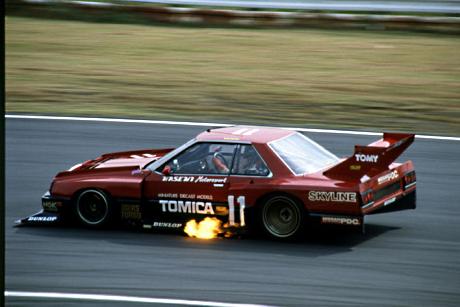
The Tomica Skyline was renowned for spitting flames each downshift
After years of absence in production car racing Nissan intended to fully dominate the new group 5 series and returned with a set of Fairladies in 1979 and lost. In 1980 and 1981 private teams used a Nissan Violet 710 and a Silvia S110 and Nissan supplied them with parts like the LZ20B engine. The S110 only had two wins during those early years In 1982 they teamed up with Nissan and had a line up of the Skyline KDR30, Silvia S12 and the Bluebird 910.
And it worked: the Tomica Nissan Skyline KDR30, driven by Hasemi Masahiro (a former KPGC10 driver), dominated along with the Impul Silvia Turbo S110 in 1982 and the S12 in 1983, driven by Hoshino Kazuyoshi, the Super Silhouette formula series in 1982 and 1983 while being backed up by the Bluebird KY910. The Skyline KDR30 had a total of 7 victories: 2 in 1982 and 5 in 1983!
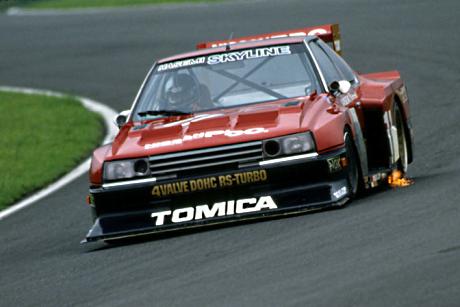
The Tomica Skyline rushing to victory
You can see an interview with Hoshino Kazuyoshi and Hesemi Masahiro in this video. (unfortunately no embedding…)
Based upon the shape of the Nissan Skyline RS R30 the Tomica Skyline KDR30 was one of the most powerful cars in the Super Silhouette formula. Note that the Skyline RS Turbo only was for sale after the Tomica Skyline KDR30 raced for over a year! Also the RS-X Turbo Tekamen (???), as known as the Iron Mask, was launched in august 1983 which is almost at the end of Super Silhouette Formula era. The car never got facelifted to match up with the RS-X new front end.
Huge spoilers were needed to keep the car on the ground and even the rear end was lengthened to create even more downforce on the rear wheels. To keep the weight down (1005kg!) the car featured a tubular chassis with only partly a monocoque design of aluminum. All exterior was made from fibreglass and of course they needed a 2 liter racing spec engine to power this beast.
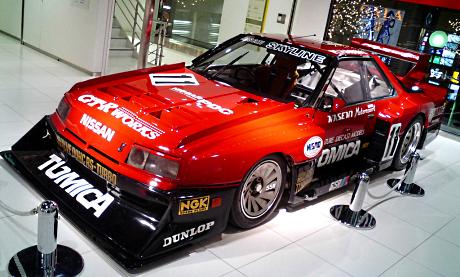
How we often see the Tomica Skyline nowadays
The car featured the LZ20B engine. The LZ engine was back then the racing spec engine by Nissan and was based upon the L engine (many flavors) featuring a different head with a 16 valve twin cam. So the LZ20 was basically an overbored L20 engine (2082 cc instead of 1952 cc) with a special twin cam 16 valve head on it. The LZ20 engine was first used in a Nissan Violet A10 doing a safari rally but featured in many formula race cars later on.
The LZ20B used in the Skyline KDR30 was improved a lot over the years and featured electronic fuel injection and turbo charging through a T05B turbo. It was able to output 570ps (563bhp) at 7600 rpm and delivered 539 nm at 6400 rpm. The competing Silvia Turbo S12 and Bluebird 910 did also have the same LZ20B engine but both were entirely different tuned: some sources say the Silvia was only capable of 500ps and it did that at 8000 rpm. For the Silvia it didn’t really matter because it was much more streamlined than the Skyline and Bluebird.
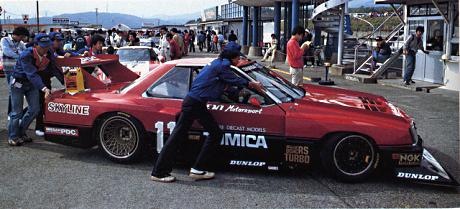
The Tomica Skyline being pushed from the pits to the track
To keep the car on the track SSR provided the front rims of 15 inch and the rear rims of 19 inch in diameter. Note that the turbine lookalike rims only featured during the 1983 and 1984 season: in 1982 it featured Rays mesh type rims as seen in the picture above. The Dunlop tires were 270mm wide and at the rear 350mm, that is almost as wide as the current Formula one spec! Also the car was slowed down by four Lockheed disk brakes with four pistons per caliper!
In this old video you can see a highlight on the Skyline KDR30:
You can really see the LZ20R, the intercooler and the big lockheed disk brakes well in this video.
And in part 2 you can see it perform during a race:
Also this car gets confused with the Group C Nissan Skyline RS Turbo C which also featured the number 11 in some occasions. It looks quite similar but is not the same car. This car was ordered by a Nissan dealer in South Africa to feature in the Kyalami 9 hour endurance race in 1982 and had to meet the Group C specifications. It is lower than the Super Silhouette Formula counterpart (different height regulations) and has a different front and rear. The car was used in a few other Group C races as well but was never really successful.
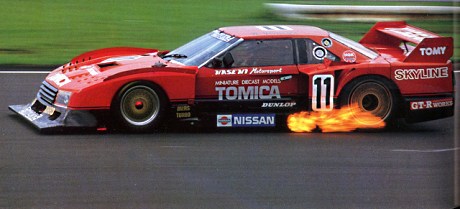
Nissan Skyline RS Turbo C (Group C) is a different car!
Nowadays the car is still regarded as an incredible piece of history. It marked the return of the Skyline to the racing circuits which was very important for the Japanese audience. It even resulted in the hope the GT-R designation would return on the Skyline but Nissan waited with that till 1989 with the debut of the R32. You can still buy lots of merchandise around the Tomica Skyline KDR30 Super Silhouette formula: diecast models, model kits, posters and it even featured in Gran Tourismo 2 as a price car in the 80’s Sports Car Cup. 😀
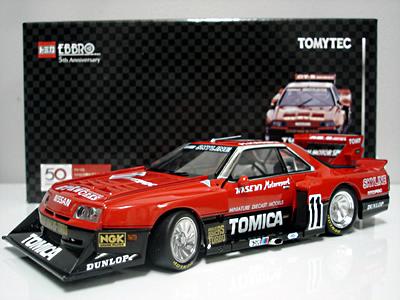
The Tomica Skyline available as diecast model from Ebbro
The funny thing is that I was unable to find a Tomica diecast of the Tomica Skyline KDR30 Super Silhouette so far… So if anyone found one: let me know! 😉
I really understand why the looks of this car got copied in so many ways: it looks like an unleashed beast when driving on the circuit! It was an incredible and outragious car at the same time! And eventhough it only shared its front and tail lights with the original Skyline RS it is still an icon for the whole Skyline R30 generation.
by banpei with 5 commentsPopular Bosozoku cars: Nissan Skyline C210 Japan
This week we feature one of the most popular bosozoku style cars: the Skyline C210, also known as the Skyline Japan. Only the Skyline C110 and Nissan Laurel are more popular than the Skyline Japan.
This Skyline may be well known amoung the visitors here, our logo is showing one of the headlights of this Skyline:
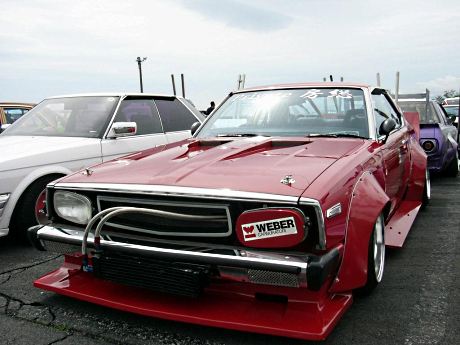
Bosozoku style Skyline C210
In my opinion the best bosozoku styled Skyline C210 and maybe even the best styled of all bosozoku styled cars I’ve seen! It has got almost everything right: the oil cooler, headlight and grille swap from a Laurel, wide over fenders, wide sideskirts, big grachan styled lip and spoiler. Only thing missing is the sharknose but that would ruin this car I guess.
Speaking of sharknoses:
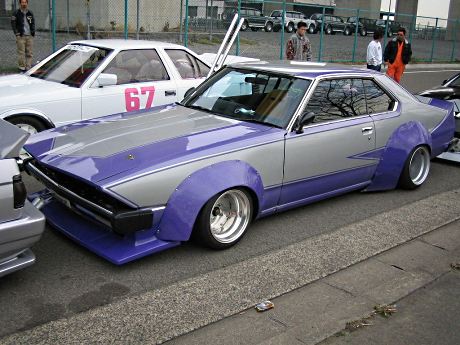
Sharknosed Skyline C210
A good example of the many sharknosed Skyline C210s I’ve seen. Sharknoses are most probably popular on the Skyline Japan because of its longer bonnet (6 cylinder engines only) and boxy image. It makes the bonnet look even larger, like on the G-nosed Fairlady Z S30, and it just looks right in combination with the trunk sloping downwards.
Also very beautiful and popular on the Skyline Japan is the kyusha look:
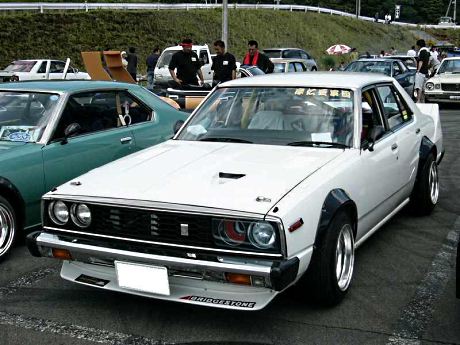
Kyusha styled Skyline C210
This example is just about right: a small cooling duct for the turbo in the bonnet, small overfenders, a decent spoiler and a 70s sports lip. The removal of the left headlight in favor of the air intake is also a nice choice, however without it the car would have been perfect.
In august 1977 Nissan launched the C210 as the 5th Skyline: the successor of the Skyline C110 (better known as the Kenmeri Skyline) which featured a coupe, sedan and estate as bodystyles. It got, just like the Kenmeri, its nickname from the Skyline tv advertisements which praised it as the “All new Japan Skyline”
The car was just as popular as the Kenmeri eventhough this Skyline never got a GT-R badge nor raced! Due to the oil crisis Nissan ruled out any performance designation on their cars to prevent a bad image.
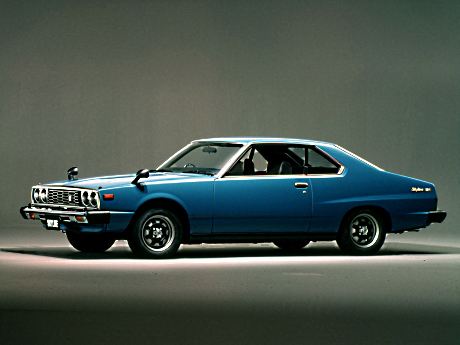
Factory stock Nissan Skyline C210
However after a few years the oil crisis was already forgotten and racecars entered the turbo age. Nissan responded in April 1980 with the Skyline GT-EX featuring a 2 liter L20ET turbo engine and this was the first Japanese production vehicle ever to make use of a turbo engine!
Back then this turbo engine was very crude compared to what we are used to nowadays: the L20ET did not feature an intercooler nor a blowoff valve however it did feature an emergency release valve in case the pressure became too high, so imagine how this car must have felt when driving it: big turbo lag and the turbine stalling when you release the throttle while the exhaust gasses have no where to go! Scary!
Talking about engines, the Skyline C210 had only a limited range of engines: the coupe and sedan only featured the Nissan L engine ranging from 1.6 to 2.0 liter and of course the 2.0 liter L20ET turbo. The estate did feature a 2.8 diesel engine and the export models did feature a 2.4 and 2.8 variant of the L engine. This turbo engine delivered an extra 15HP above the normal 2 liter engine and outputted 145hp. It may not sound as much, but remember this was dated only at the beginning of the turbo age!
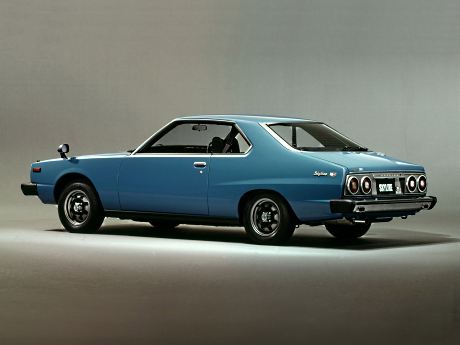
Factory stock Nissan Skyline C210
The TI models (1.6 and 1.8 4 cylinder cars) got rectangular taillights while the GT models (2.0 and turbo 6 cylinder cars) got the round taillights.
The 4 cylinder cars were 10 cm shorter between the front wheelarch and the front door than the 6 cylinder cars. This was basically the same solution as used with the Celica XX: to fit the 6 cylinder engine the chassis was lenghtend.
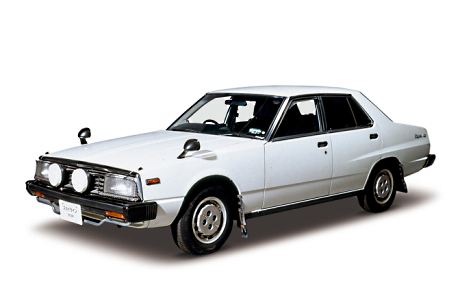
Factory stock facelifted Nissan Skyline C210
In august 1979 the C210 gets a facelift: the round headlights are replaced by square headlights.
The facelifted version of the car is very well known from Seibu Keisatsu (????) as the black Skyline GT-EX Turbo Super Machine-X cop car:
It was featuring a lot of nifty 80s cop stuff like an automatic high speed camera, electrically operated patrol light, a gun behind the grille and of course a complete computer!
The exposure of Skyline thanks to the GT-EX turbo Super Machine-X boosted sales of the Skyline C210 so much that Nissan decided to donate brand new models as the new police cars. In this way the 280ZX, Skyline R30 and S110 Gazelle were plugged by Nissan this way.
In august 1981 the life of the Skyline C210 ended and it was replaced by the Skyline R30.
I really understand why this car is one of the most popular styled cars: it has got a turbo (ahum)) and it just looks right with or without a lot of modifications!
by banpei with no comments yetPopular Bosozoku cars: Nissan Fairlady S30
This week we have a very popular Bosozoku style car and I really had trouble with deciding which pictures would feature this item. This week we feature the very popular Nissan Fairlady Z S30:
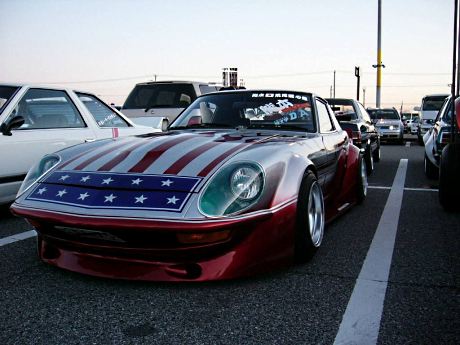
Yanky style Fairlady S30 (with stars and stripes)
Most of the Fairlady Zs I came accross were Yanky style like the one above. It reflects how the Bosozoku cars were styled in the late 80s!
Especially this one is very well known:
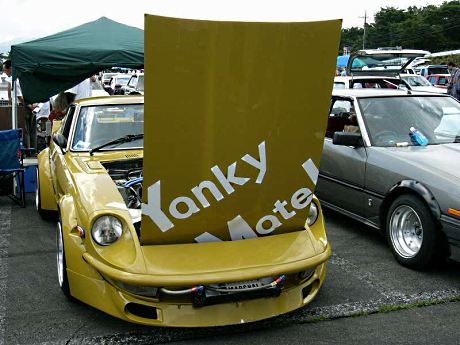
Yanky Mate! Fairlady S30 replica
This is a Yanky Mate! replica of the Shakotan Boogie manga/anime. This Fairlady S30 featured in two colors in the manga: blue (early) and yellow (late). With the craze around Shakotan Boogie in the early 90s you can imagine that replicas of this car are very popular.
Another style which can be found in many numbers are the Gran Chan styled Fairladies:
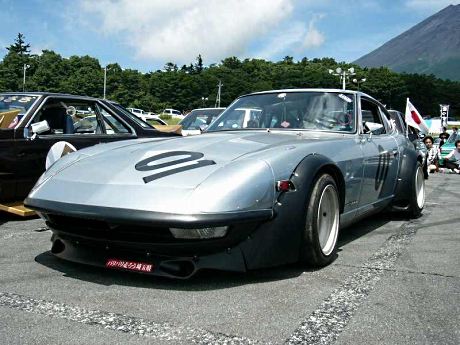
Gran Chan style Fairlady S30
With big fender extenders, headlight covers and the bonnet/lip having smooth aerodynamic lines it really reflects the Fairladies used during races in the late 70s. Very beautifully styled!
And of course we have the Bosozoku styled Fairlady, but they are bit rarer than the other two styles so I only post a 280ZX:
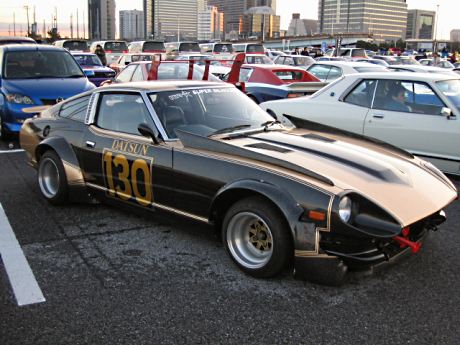
Bosozoku style Fairlady 280ZX
This 280ZX model has a lot of fins, spoilers, ventilation holes and a really nice horn! With its paiting scheme it really looks bad ass Bosozoku styled, but its styling is not over the top. Good example in my opinion.
The Nissan Fairlady Z S30 (also known as the 240Z, 260Z and 280Z overseas) came out in Japan as the successor of the 60s Nissan Fairlady. This was a small compact roadster competing with European roadsters and it sold quite well in Japan and overseas. Nissan decided it needed a replacement for the roadster and teamed up with Yamaha. The Yamaha prototype did not meet the expectations of Nissan and Nissan terminated the cooperation and Yamaha turned to Toyota and created the 2000GT out of this prototype.
Nissan then decided it needed a more Americanized GT car which was stylish, innovative, fast, reliable and most importantly sharing parts with other Nissans to make it inexpensive! This became the Fairlady Z and in 1969 the production of this car started:
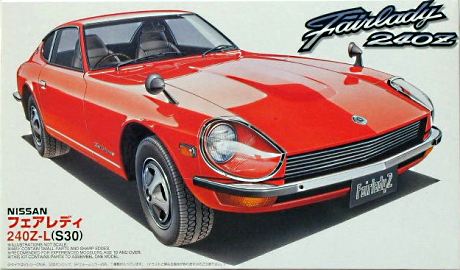
Factory stock Fairlady Z S30
As you can see: in stock form it may look awfull today, but back then it was one of the most stylish GT cars ever!
In Japan the car was launched with two engines: a 6 cylinder SOHC L20A (shared with the Bluebird) outputting 130hp and a limited run called Z432 featured the high performance 6 cylinder DOHC S20 (shared with the Skyline GTR) outputting 160 hp.
Later in Japan the limited run of the 240ZG appeared: a L24 (initially used for export market) powered Fairlady Z with a new aero dynamic nose, wide overfenders, acrylic headlight covers (like the one in the first picture), fender mirrors and a rear spoiler. This 240ZG was meant to homologate an uprated version for Group 4 racing. The nose was later on sold as a seperate option called the “G-nose”.
The Fairlady Z S30 appeared in many rally and circuit race events and became just about as famous as the Hakosuka Skyline GTR.
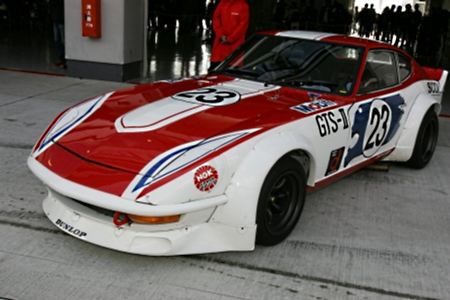
Factory racing Fairlady Z S30
Nowadays the Fairlady Z still has a huge following, especially after the animation version of Wangan Midnight featuring a blue Devil Z and Hakosukas suffering from insane price increases. Popular engine swaps are either the bigger engines L24, L26 and L28 or the whole drivetrain with the RB25 of a Skyline GTS.
Personally I really would like to own one someday: those Z cars are just awesome! 🙂
by banpei with no comments yetPopular Bosozoku cars: Toyota Celica XX
As promised: this week we feature the Celica XX in the Popular Bosozoku Cars. 🙂
We kick off with a subtle Kyusha styled example:
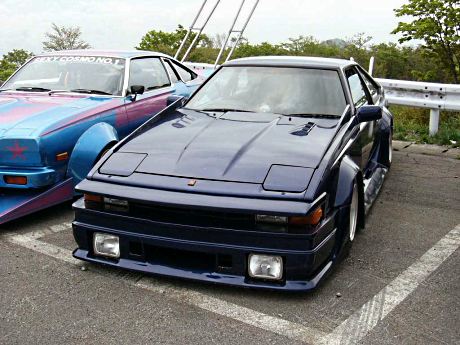
Kyusha styled Toyota Celica XX
The kouki Celica XX (facelifted second version) already featured fender flares on its own, but this car above has extended those flares extremely and added some sideskirts to it. Nice example of Kyusha style on the more modern cars if there were no fins on the hood and a large exhaust.
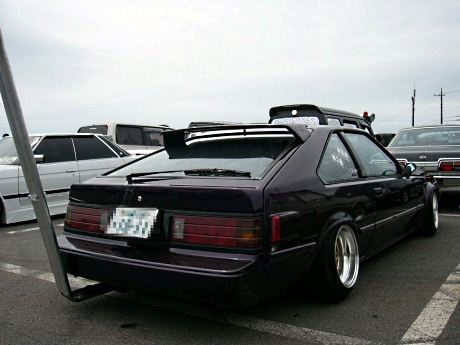
Shakotan styled Toyota Celica XX
This Shakotan styled Toyota Celica XX had it all: extremely lowered to the ground, deep dish wheels still fitting in the original fenders and a big pipe sticking out from under the rear bumper! Note that the wing on the hatch is the factory spec upper spoiler for some of the zenki Celica XX (pre-facelift) models.
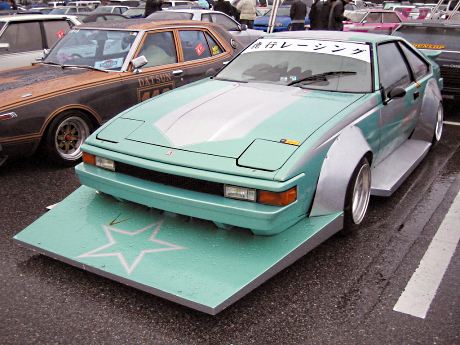
Bosozoku styled Toyota Celica XX
Everything is boso on this Bosozoku styled Toyota Celica XX: big lip on the front, single windshield wiper, wacky color, racing mirrors, extremely wide fenders and some diy sideskirts to stand on while parading through town!
Funny enough I could not find any racing replicas through all pictures I have of Bosozoku styled Celcia XXs. Eventhough the Celica XX did not feature the Super Silhouette formula, there were a lot of them racing around the world back in the early 80s and definitely it must have inspired some people to make replicas of them, just like the Granchan styling were replicas of the old Super Silhouette racers.
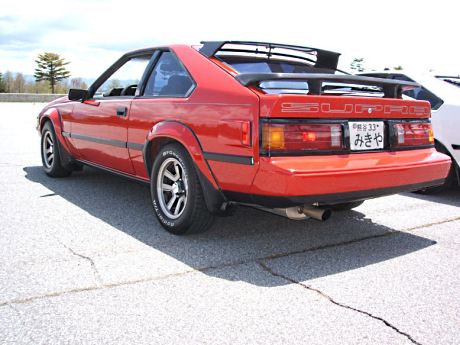
Factory stock kouki Toyota Celica XX
The first generation Celica XX (pronounced as “double X”) was a lengthened Celica A4 to fit the 2.6 liter 4M or the 2.0 liter 1M into the Celica. Basically the first generation Celica XX did not look much different from the normal Celica except it had a very long bonnet. Later spec Celica XX did receive the more powerful 2.8 liter 5M-E and IRS, which was top of the range.
The second generation Celica XX succeeded the first generation and featured a 2.0 liter 1M-T turbo as the basic engine, a naturally aspired 2.8 liter 5M-GE as the midrange with lots of torque and a high revving naturally aspired 2.0 liter 1G-GEU as top of the range. At the same time Toyota was also working together with Lotus on the MR2 and had a good idea: have Lotus do the suspension on the Supra and in exchange have Lotus reuse some of the parts for their own car lineup! (the Lotus Excel for instance shares the rims and gearbox)
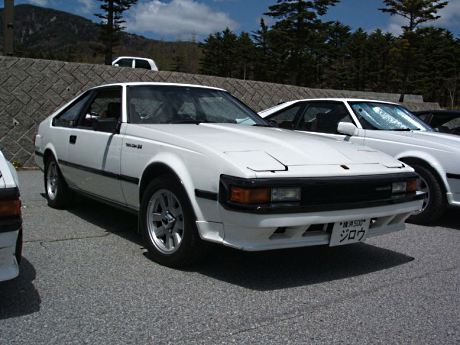
Factory stock zenki Toyota Celica XX
As stated before: the major difference between the zenki and the kouki models were the extended fenders with the wellknown fender flares. This resulted in the second generation having smaller diameter rims: 14 inch instead of 15 inch!
After the second generation Celica XX it became renamed to Supra, which was the overseas name for the Celica XX, so it could be split from the newer FWD Celica range. The Supra (mk. III) remained the A platform and got the designation A7.
by banpei with no comments yetPopular Bosozoku cars: Mazda Cosmo RX5
To stay with the 70s styling this week I will highlight the Mazda Cosmo RX5:
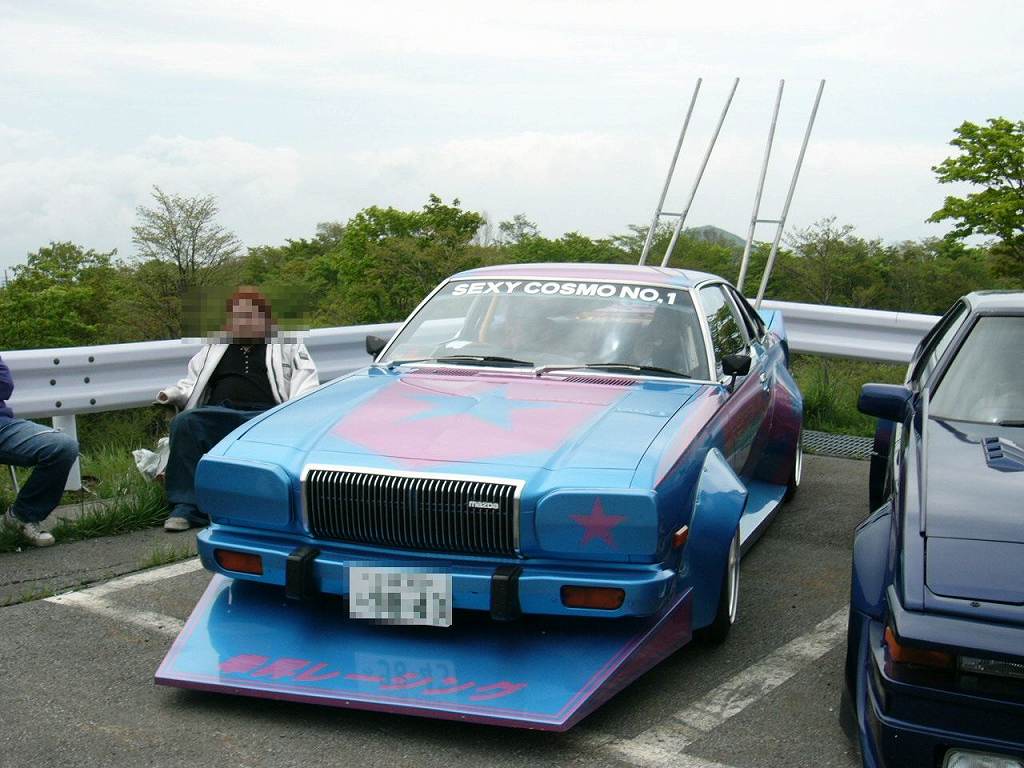
Bosozoku style Mazda (sexy) Cosmo RX5
Just like last weeks Mark II X3/X4 and the Gloria/Cedric C330 I did two weeks ago the Mazda Cosmo RX5 has a very distinct bodystyle and can easily be spotted between all cars on Bosozoku meetings.
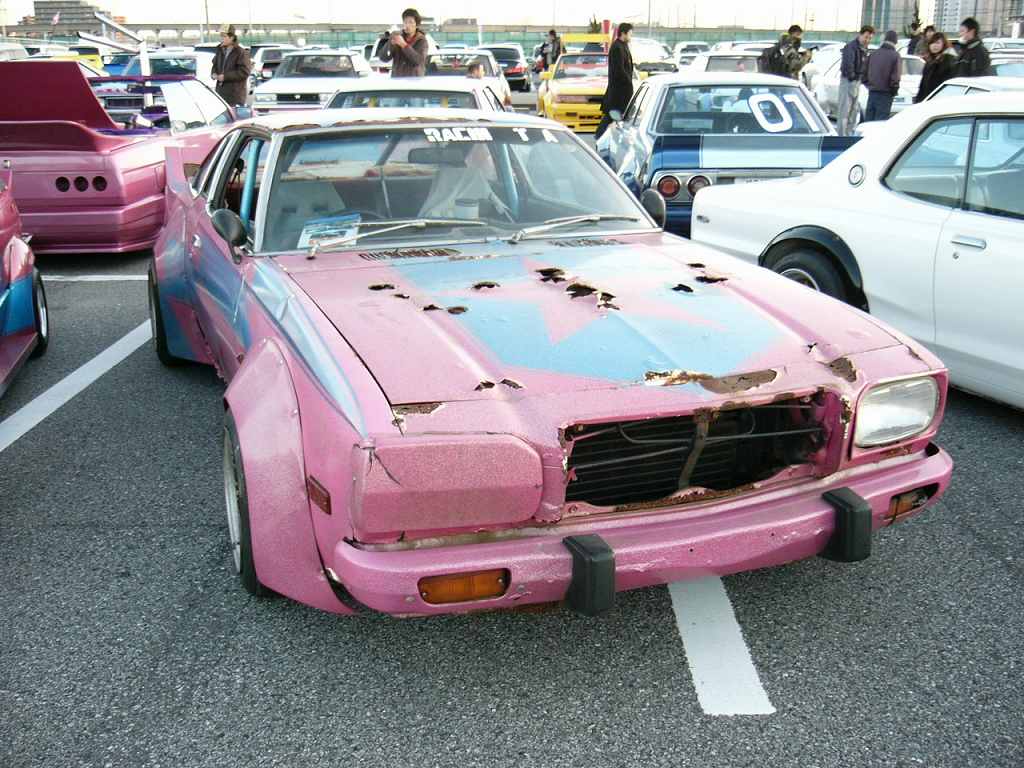
What happened? Boso got shot?
The bodyshape of the Mazda Cosmo RX5 has some lines which make it look mean. The Cosmo RX5 lines really resemble Mazda’s design linup of that era: all American styling! I think this also reflects in the modifications made on this car, especially with the car in the picture above. Wild wild west yanky style!
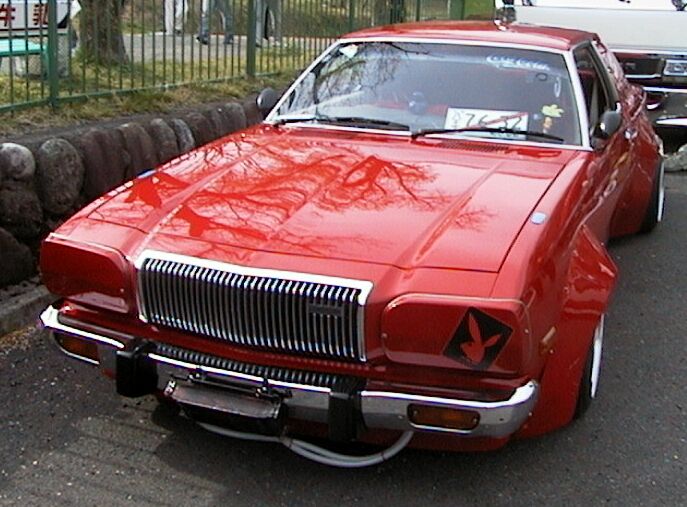
Nicely styled bosozoku Mazda Cosmo RX5
The weird thing is that I actually couldn’t find any non Bosozoku styled Mazda Cosmo RX5. No Shakotan or Kyusha styled cars, only the bad ass modified bosozoku cars… Big wide fenders, oil coolers sticking out of the grille, big ducktail spoilers and exhausts high in the air: I’ve seen it all!
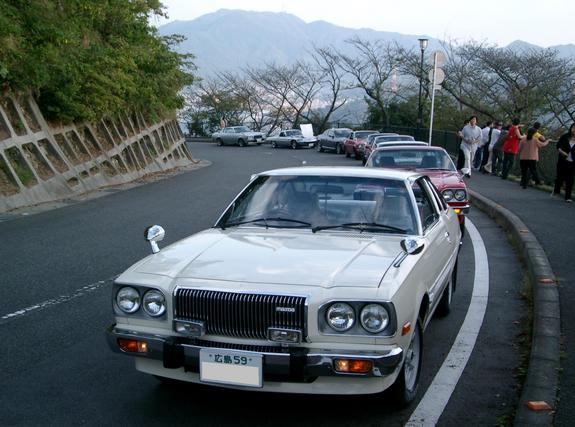
Factory stock Mazda Cosmo AP RX5
The Mazda RX5 was the successor of the first Mazda Cosmo and not the Mazda RX4. The RX4 was the wankel engined Luce, while the Luce is more a luxurious sedan with a wankel engine the Cosmo is the more sporty car. The car was called Mazda Cosmo AP in Japan while outside Japan it sold as the Mazda RX5. In some countries is was sold as the Mazda 121 featuring a 1.8 liter SOHC piston engine.
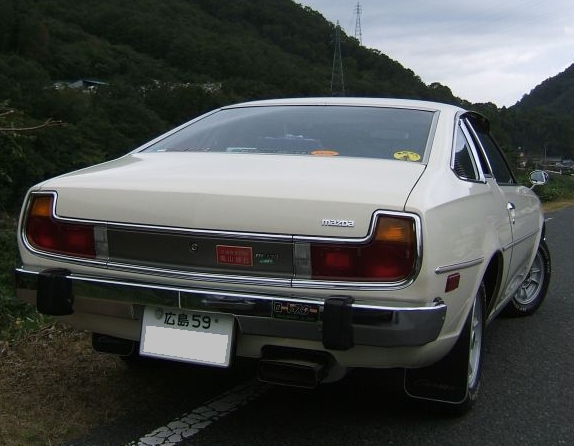
Factory stock Mazda Cosmo AP RX5
The Mazda Cosmo featured the 12A or the 13B engine in Japan, while overseas all Mazda RX5s featured the 13B. The reason for this decision was because overseas meant America. Americans, of course, favored larger displacements back then. The 13B was basically a widened 12A engine which caused the displacement to increase to 1308cc. That’s a 15% increase in displacement on a Wankel engine!
The 13B was a big improvement above the 12A because it was designed for high performance and low emissions at the same time. AP stood for Anti-Pollution and this designation was adapted on all Japanese Cosmos.
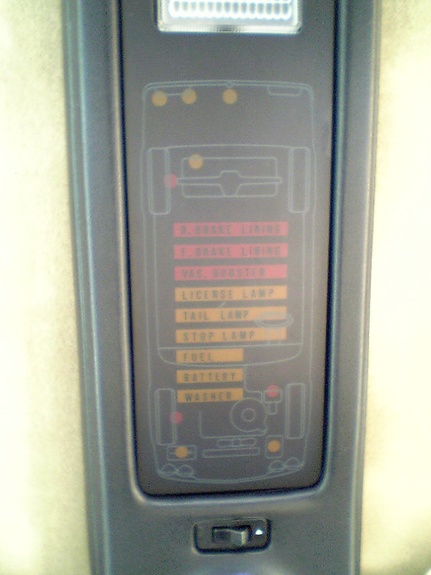
Mazda Cosmo warning system
Even though the Mazda Cosmo AP RX5 was the more sportier car it did feature a lot of luxury which could only be found in the high end Luce. Take for instance this warning system: it checked the functioning of several systems in the car. Nowadays it may sound as trivial with all new cars already featuring satellite navigation but back then it was unlike anything seen so far!
I really love the styling of the Cosmo AP! Too bad this car only sold in Europe as the Mazda 121 with the piston engine… 🙁
by banpei with 2 comments